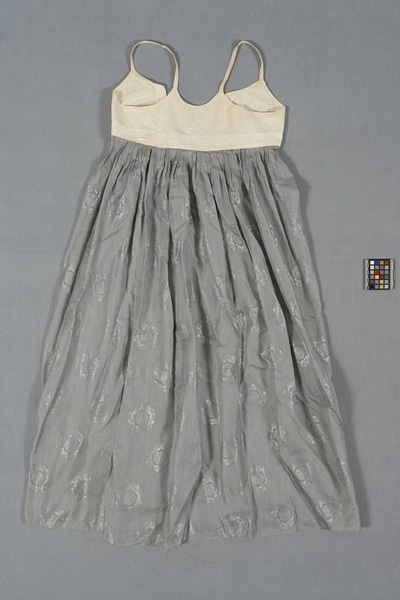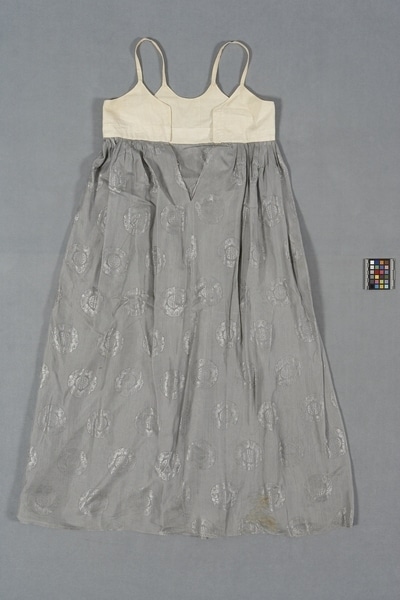Skirt Item Number: Ed1.324 from the MOA: University of British Columbia


Description
Skirt made of two panels of lightweight grey silk gauze patterned with roundels of bats surrounding a circular form of wide lines forming an even cross with arms curving around and bent inwards. The gauze fabric has an overall pattern of small rectangles. The skirt is open at the back, where the right panel overlaps that on the left. The skirt panels are pleated and inserted into a band of unbleached cotton, the upper edge of which is scalloped, with the points of the scallops meeting the ends of two shoulder straps of the same material. The band opens at the front, and the front seam is left unstitched near the top.
History Of Use
Such extravagant gauze fabrics were favoured in the postwar years. Gauze “Ra” was worn in the spring and summer. The straps attached to the curved shape of the skirt band were innovations introduced after the opening of Korea to the outside world in the late 19th century, replacing the simple waistband with long ties of the traditional “Chi-ma”. The new style was considered to be more modest, as it covered the breasts, and more comfortable.
Specific Techniques
The garment is machine sewn except for the stitches attaching the band, which are done by hand so as to be invisible on the outside.
Iconographic Meaning
The bat is a symbol of good fortune. It also is associated with women.
Narrative
Worn by Norma Elrod while living in Korea. This skirt would be worn with jacket Ed1.323. Most of the clothing in the J. McRee Elrod Collection was made for him and his family by friends while they were living in Korea, much of it by Kim, Sung Sook. She and her family lived cooperatively in the same house as the Elrod family. While they were there, the Elrods preferred to wear Korean clothing on very cold days and for social occasions. They found it to be more comfortable than western clothing in cold weather, as public buildings were unheated in the period immediately following the Korean War. It also was more comfortable for floor seating in Korean homes, and easier to store with limited furniture than western clothing.
Item History
- Made by Sung Sook Kim (Maker) in Seoul, Korea between 1955 and 1960
- Collected between 1955 and 1960
- Owned by Norma Elrod
- Owned by J. McRee Elrod before October 13, 1976
- Received from J. McRee Elrod (Donor) on October 13, 1976
What
- Name
- Skirt
- Identification Number
- Ed1.324
- Type of Item
- skirt
- Material
- silk fibre, cotton fibre and dye
- Manufacturing Technique
- spun, dyed, woven, cut, pleated and sewn
- Overall
- height 119.0 cm, width 84.0 cm
Who
- Culture
- Korean
- Creator
- Sung Sook Kim (Maker)
- Previous Owner
- Norma Elrod and J. McRee Elrod
- Received from
- J. McRee Elrod (Donor)
Where
- Holding Institution
- MOA: University of British Columbia
- Made in
- Seoul, Korea
When
- Creation Date
- between 1955 and 1960
- Collection Date
- between 1955 and 1960
- Ownership Date
- before October 13, 1976
- Acquisition Date
- on October 13, 1976
Other
- Item Classes
- textiles
- Condition
- fair
- Accession Number
- 0335/0007 b